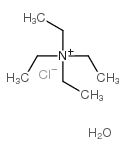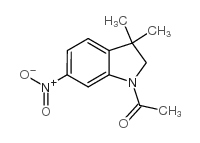68696-18-4
| Name | Tetraethylammonium chloride monohydrate |
|---|---|
| Synonyms |
MFCD00149992
EINECS 200-267-5 tetraethylazanium,chloride,hydrate |
| Density | 1.0801 |
|---|---|
| Molecular Formula | C8H22ClNO |
| Molecular Weight | 183.71900 |
| Exact Mass | 183.13900 |
| PSA | 9.23000 |
|
Section 1. Chemical Product and Company Identification Tet r aet hylammoniumc h l o r i d e , Catalog Common Name/ Number(s). Trade Name monohydrate 68696-18-4; 56-34-8
CAS# (anhydrous) Tetraethylammonium chloride, monohydrate Section 3. Hazards Identification Hazardous in case of skin contact (irritant), of eye contact (irritant). Slightly hazardous in case of ingestion, of Potential Acute Health inhalation. Effects CARCINOGENIC EFFECTS: Not available. Potential Chronic Health MUTAGENIC EFFECTS: Not available. Effects TERATOGENIC EFFECTS: Not available. DEVELOPMENTAL TOXICITY: Not available. Repeated or prolonged exposure is not known to aggravate medical condition. Section 4. First Aid Measures Check for and remove any contact lenses. In case of contact, immediately flush eyes with plenty of water for at least Eye Contact 15 minutes. Cold water may be used. Get medical attention. In case of contact, immediately flush skin with plenty of water. Cover the irritated skin with an emollient. Remove Skin Contact contaminated clothing and shoes. Cold water may be used.Wash clothing before reuse. Thoroughly clean shoes before reuse. Get medical attention. Serious Skin ContactNot available. If inhaled, remove to fresh air. If not breathing, give artificial respiration. If breathing is difficult, give oxygen. Get Inhalation medical attention. Serious InhalationNot available. Do NOT induce vomiting unless directed to do so by medical personnel. Never give anything by mouth to an Ingestion unconscious person. Loosen tight clothing such as a collar, tie, belt or waistband. Get medical attention if symptoms appear. Serious IngestionNot available. Section 5. Fire and Explosion Data Flammability of the Product May be combustible at high temperature. Auto-Ignition Temperature Not available. Not available. Flash Points Not available. Flammable Limits These products are carbon oxides (CO, CO2), nitrogen oxides (NO, NO2...), halogenated compounds. Products of Combustion Fire Hazards in Presence of Slightly flammable to flammable in presence of heat. Various Substances Risks of explosion of the product in presence of mechanical impact: Not available. Explosion Hazards in Risks of explosion of the product in presence of static discharge: Not available. Presence of Various Substances SMALL FIRE: Use DRY chemical powder. Fire Fighting Media LARGE FIRE: Use water spray, fog or foam. Do not use water jet. and Instructions Not available. Special Remarks on Fire Hazards Not available. Special Remarks on Explosion Hazards Tetraethylammonium chloride, monohydrate Section 6. Accidental Release Measures Use appropriate tools to put the spilled solid in a convenient waste disposal container. Finish cleaning by spreading Small Spill water on the contaminated surface and dispose of according to local and regional authority requirements. Use a shovel to put the material into a convenient waste disposal container. Finish cleaning by spreading water on Large Spill the contaminated surface and allow to evacuate through the sanitary system. Section 7. Handling and Storage Keep away from heat. Keep away from sources of ignition. Ground all equipment containing material. Do not Precautions ingest. Do not breathe dust. If ingested, seek medical advice immediately and show the container or the label. Keep away from incompatibles such as oxidizing agents. Keep container tightly closed. Keep container in a cool, well-ventilated area. Storage Section 8. Exposure Controls/Personal Protection Use process enclosures, local exhaust ventilation, or other engineering controls to keep airborne levels below Engineering Controls recommended exposure limits. If user operations generate dust, fume or mist, use ventilation to keep exposure to airborne contaminants below the exposure limit. Personal ProtectionSafety glasses. Lab coat. Dust respirator. Be sure to use an approved/certified respirator or equivalent. Gloves. Personal Protection in Case Splash goggles. Full suit. Dust respirator. Boots. Gloves. A self contained breathing apparatus should be used to avoid inhalation of the product. Suggested protective clothing might not be sufficient; consult a specialist BEFORE of a Large Spill handling this product. Exposure LimitsNot available. Section 9. Physical and Chemical Properties Solid. (Deliquescent solid. Crystalline solid.)Not available. Physical state andO dor appearance Not available. Taste 183.72 g/mole Molecular Weight Colorless to light yellow. Color Not available. pH (1% soln/water) Not available. Boiling Point 94°C (201.2°F) 102 C. Melting Point Not available. Critical Temperature Not available. Specific Gravity Not applicable. Vapor Pressure Not available. Vapor Density Not available. Volatility Not available. Odor Threshold Not available. Water/Oil Dist. Coeff. Not available. Ionicity (in Water) See solubility in water. Dispersion Properties Easily soluble in cold water. Solubility Tetraethylammonium chloride, monohydrate Section 10. Stability and Reactivity Data The product is stable. Stability Not available. Instability Temperature Conditions of Instability Excess heat, incompatible materials Incompatibility with various Reactive with oxidizing agents. substances Non-corrosive in presence of glass. Corrosivity Not available. Special Remarks on Reactivity Not available. Special Remarks on Corrosivity Will not occur. Polymerization Section 11. Toxicological Information Inhalation. Ingestion. Routes of Entry Acute oral toxicity (LD50): 833 mg/kg [Mouse]. Toxicity to Animals Chronic Effects on Humans Not available. Other Toxic Effects onHazardous in case of skin contact (irritant). HumansSlightly hazardous in case of ingestion, of inhalation. Not available. Special Remarks on Toxicity to Animals Not available. Special Remarks on Chronic Effects on Humans Special Remarks on otherAcute Potential Health Effects: Toxic Effects on HumansSkin: Causes skin irritation. Eyes: Causes eye irritation. Inhalation: May cause respiratory tract irritation. Ingestion: May cause nausea, vomiting, diarrhea. May affect behavior/central nervous system/peripheral nervous system (paresthesis, flaccid paralysis, change in motor activity, muscle weakness, somnolence, tremor, ataxia), respiration (respiratory depression). Section 12. Ecological Information Not available. Ecotoxicity Not available. BOD5 and COD Products of Biodegradation Possibly hazardous short term degradation products are not likely. However, long term degradation products may arise. The products of degradation are more toxic than the product itself. Toxicity of the Products of Biodegradation Not available. Special Remarks on the Products of Biodegradation Tetraethylammonium chloride, monohydrate Section 13. Disposal Considerations Waste must be disposed of in accordance with federal, state and local environmental control Waste Disposal regulations. Section 14. Transport Information Not a DOT controlled material (United States). DO T Cl assi fi cati on Not applicable. Identification Not applicable. Special Provisions for Transport DO T (Pi ctograms) Section 15. Other Regulatory Information and Pictograms No products were found. Federal and State Regulations California prop. 65: This product contains the following ingredients for which the State of California has found to California cause cancer which would require a warning under the statute: No products were found. Proposition 65 Warnings California prop. 65: This product contains the following ingredients for which the State of California has found to cause birth defects which would require a warning under the statute: No products were found. Other RegulationsEINECS: This product is not on the European Inventory of Existing Commercial Chemical Substances. Canada: Not listed on Canadian Domestic Substance List (DSL) or Canadian Non- Domestic Substance List (NDSL). China: Not listed on National Inventory. Japan: Not listed on National Inventory (ENCS). Korea: Not listed on National Inventory (KECI). Philippines: Not listed on National Inventory (PICCS). Australia: Not listed on AICS. WHMIS (Canada) CLASS D-2B: Material causing other toxic effects (TOXIC). Other Classifications R36/38- Irritating to eyes and skin.S26- In case of contact with eyes, rinse DSCL (EEC) immediately with plenty of water and seek medical advice. S28- After contact with skin, wash immediately with plenty of water. S37/39- Wear suitable gloves and eye/face protection. Health Hazard HMIS (U.S.A.)2 National Fire Protection 1 Flammability 1 Association (U.S.A.) Fire Hazard 1 0 Reactivity Health Reactivity0 Specific hazard Personal Protection E WHMIS (Canada) (Pictograms) Tetraethylammonium chloride, monohydrate DSCL (Europe) (Pictograms) TDG(Canada) (Pictograms) ADR (Europe) (Pictograms) Protective Equipment Gloves. Lab coat. Dust respirator. Be sure to use an approved/certified respirator or equivalent. Wear appropriate respirator when ventilation is inadequate. SECTION 16 - ADDITIONAL INFORMATION N/A |
| Hazard Codes | Xn |
|---|---|
| Risk Phrases | R36/37/38 |
| Safety Phrases | S26-S36 |
| WGK Germany | 3 |
| RTECS | BS6125000 |
| HS Code | 2923900090 |
| Precursor 0 | |
|---|---|
| DownStream 2 | |
| HS Code | 2923900090 |
|---|---|
| Summary | 2923900090 other quaternary ammonium salts and hydroxides。Supervision conditions:None。VAT:17.0%。Tax rebate rate:9.0%。MFN tariff:6.5%。General tariff:30.0% |



![4-METHYLENE-3,4-DIHYDRO-2H-PYRANO[3,2-B]PYRIDINE structure](https://image.chemsrc.com/caspic/130/405174-46-1.png)
